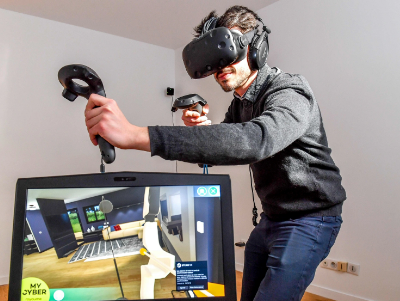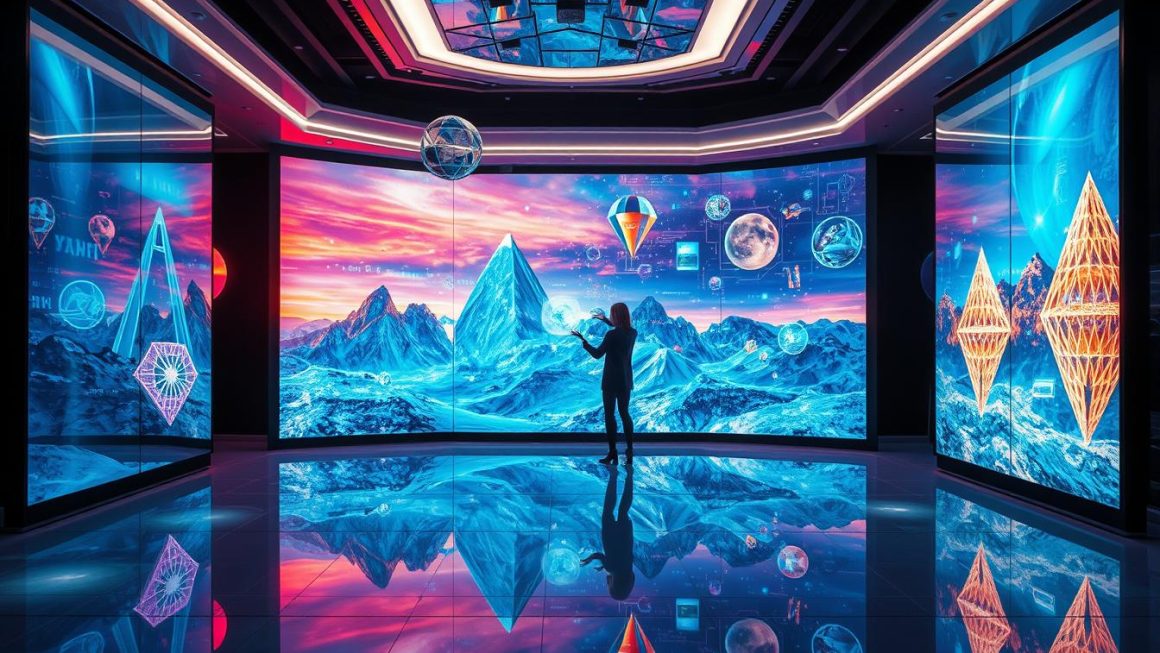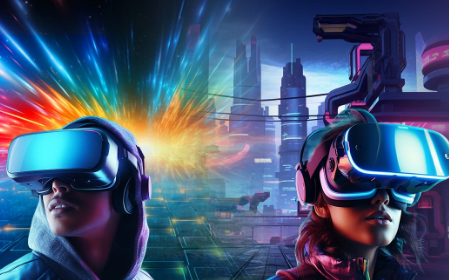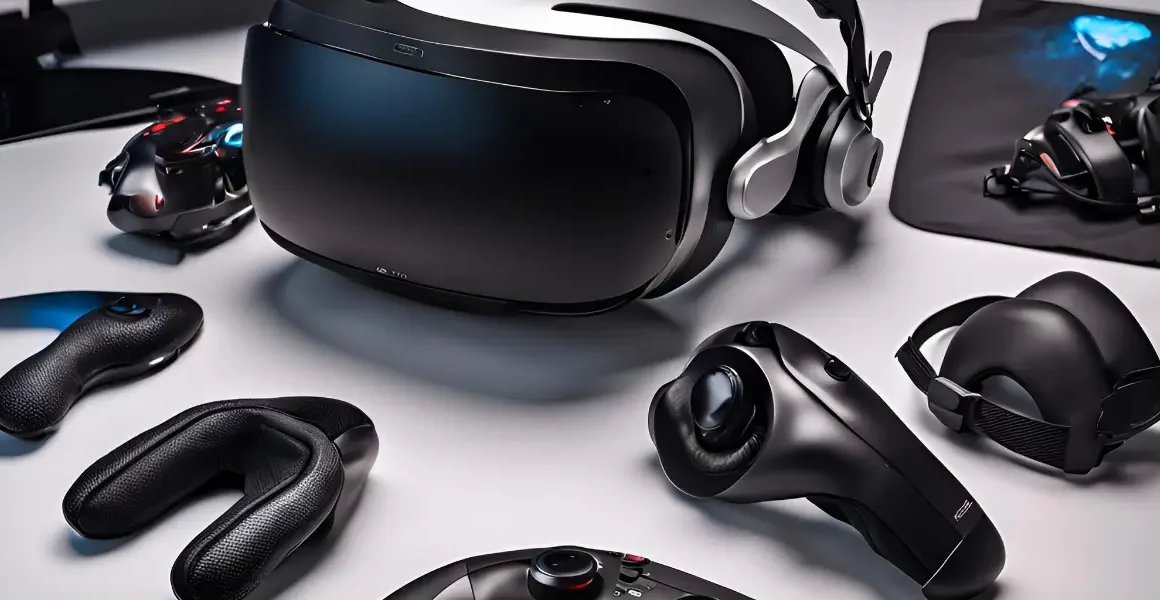
Immersive virtual reality experiences are revolutionizing how we interact with digital content, pushing the boundaries of what’s possible in virtual environments. As we enter 2025, the demand for engaging VR experiences continues to surge, with the global market projected to reach $92.31 billion, driven by innovations in both technology and content creation.
Creating truly immersive virtual reality experiences requires more than just technical expertise—it demands a deep understanding of human perception, storytelling, and user interaction design. Whether you’re developing educational simulations, gaming environments, or professional training programs, the key lies in crafting experiences that transport users into convincing virtual worlds.
For those new to VR technology, our guide on Non-Immersive Virtual Reality: Exploring New Realities offers valuable insights into alternative approaches to virtual experiences.
Understanding Virtual Reality Fundamentals
Virtual reality technology has evolved significantly in recent years, offering users an unprecedented level of immersion and interactivity. At its core, VR creates computer-generated simulations of three-dimensional environments that users can interact with in ways that feel remarkably real and natural. This transformation in digital interaction has opened new possibilities across industries, from entertainment to professional training.
The Essence of Presence
The key to effective virtual reality lies in what developers call “presence” – the psychological sensation of being physically present in a virtual space. This isn’t just about visual display; it’s about creating a harmonious blend of sensory inputs that convince our brain we’re experiencing something real. When users achieve this sense of presence, they naturally engage with the virtual environment, leading to more effective and memorable experiences.
Core Technical Elements
Modern VR systems rely on several sophisticated technologies working in concert. High-resolution displays deliver crisp, stereoscopic 3D images while advanced tracking systems monitor user movements with sub-millimeter precision. Spatial audio creates convincing soundscapes that respond naturally to user position and movement, enhancing the overall sense of immersion.
Creating Comfortable Experiences
One of the most critical aspects of VR development is ensuring user comfort. This involves maintaining high frame rates, minimizing motion-to-photon latency, and implementing thoughtful movement mechanics. Successful VR experiences carefully balance visual fidelity with performance optimization, ensuring smooth, comfortable interactions that users can enjoy for extended periods.
The Impact of Integration
The true power of virtual reality emerges when these elements work together seamlessly. When precise tracking combines with responsive visuals and natural audio, users forget about the technology and become fully engaged in the experience. This integration creates opportunities for deeply immersive training simulations, compelling entertainment experiences, and innovative educational applications.
Understanding these fundamentals provides the foundation for creating effective VR experiences. As we continue to explore the development process, we’ll see how these basic principles inform every aspect of VR creation, from initial concept to final implementation.
Selecting the Right VR Hardware and Software
The success of any virtual reality project hinges significantly on choosing appropriate hardware and software solutions. This critical decision impacts not only the quality of the final experience but also the development process itself. As VR technology continues to advance, developers and creators have access to an increasingly diverse range of tools and platforms.
Hardware Considerations
Modern VR hardware has evolved to offer remarkable capabilities at various price points. High-end headsets like the Meta Quest Pro and HTC Vive Pro deliver exceptional visual fidelity and tracking precision, while more affordable options provide accessible entry points for many developers. When selecting hardware, consider your project’s specific requirements for resolution, field of view, and tracking capabilities.
Development Platforms
The choice of development platform significantly influences your project’s scope and capabilities. Industry-standard engines like Unity and Unreal Engine provide robust VR development frameworks, complete with extensive documentation and active community support. These platforms offer different advantages – Unity excels in rapid prototyping and mobile VR development, while Unreal Engine is renowned for its graphical capabilities and performance optimization tools.
Supporting Technologies
Beyond the core hardware and development platforms, consider the role of supporting technologies. Motion controllers, haptic feedback systems, and spatial audio solutions can dramatically enhance user immersion. These components should align with your project’s goals and target audience expectations.
Performance Requirements
Virtual reality demands significant computational resources to maintain smooth, comfortable experiences. Your development setup needs sufficient processing power and graphics capabilities to handle VR’s unique demands. Consider both development and target platform requirements when planning your technical infrastructure.
Scalability and Future-Proofing
As VR technology continues to evolve rapidly, choosing solutions that offer scalability becomes crucial. Select hardware and software platforms that provide clear upgrade paths and maintain active development communities. This approach helps ensure your project remains viable as technology advances and user expectations evolve.
Understanding these foundational elements of VR development infrastructure helps create a solid base for your project. The right combination of hardware and software tools empowers you to focus on creating compelling content rather than wrestling with technical limitations.
Creating Engaging VR Content and User Experience
The heart of any successful virtual reality experience lies in its ability to engage users through compelling content and intuitive interactions. While technical excellence provides the foundation, it’s the creative elements that truly captivate users and keep them coming back for more.
Storytelling in Virtual Spaces
Virtual reality transforms traditional storytelling by placing users directly within the narrative. Whether developing a training simulation or an entertainment experience, the story must unfold naturally around the user. This immersive storytelling approach requires careful consideration of pacing, user agency, and environmental storytelling techniques that guide users without breaking their sense of presence.
Designing Interactive Elements
Interaction design in VR requires a delicate balance between functionality and intuition. The most effective VR experiences feel natural, allowing users to interact with virtual objects and environments in ways that match their real-world expectations. This might include grabbing objects, manipulating tools, or navigating spaces using familiar gestures and movements.
Environmental Design
The virtual environment plays a crucial role in user engagement. Well-designed spaces guide users naturally through the experience while maintaining their interest and comfort. Consider factors like scale, lighting, and spatial audio to create environments that feel both compelling and comfortable to explore. The environment should support the narrative while providing clear visual cues that help users understand their options for interaction.
Feedback and User Guidance
Clear feedback mechanisms help users understand the results of their actions in the virtual space. Visual, auditory, and haptic feedback should work together to create a coherent experience. This includes both immediate responses to user actions and broader guidance systems that help users navigate through the experience.
Testing and Iteration
Creating engaging VR content is an iterative process that requires frequent testing and refinement. Regular user testing helps identify areas where the experience might break immersion or cause discomfort. Pay particular attention to how different users interact with your content, as VR experiences often need to accommodate a wide range of user behaviors and comfort levels.
The success of your VR project ultimately depends on how well these elements work together to create a cohesive, engaging experience. By focusing on user engagement while maintaining technical excellence, you can create virtual reality experiences that truly resonate with your audience.
Best Practices and Technical Optimization
Creating compelling VR experiences requires careful attention to both performance optimization and user comfort. Understanding and implementing industry best practices ensures your virtual reality application delivers smooth, enjoyable experiences while maintaining technical efficiency.
Performance Optimization
Performance in virtual reality directly impacts user comfort and engagement. Maintaining consistent frame rates and minimizing latency are critical for preventing motion sickness and preserving immersion. Modern VR applications should target at least 90 frames per second while managing complex scenes and interactions.
User Comfort Considerations
Extended VR sessions can be physically and mentally demanding for users. Implementing comfort features like teleportation options, customizable movement speeds, and adjustable interface elements helps accommodate different user preferences and comfort levels. Regular break reminders and clear visual anchors can also help reduce user fatigue.
Technical Implementation
Efficient code and asset management play crucial roles in VR performance. Implement level-of-detail systems, optimize asset loading, and use appropriate culling techniques to maintain smooth performance. Consider using asynchronous loading for large assets and implementing efficient memory management strategies.
Testing and Quality Assurance
Thorough testing across different VR hardware configurations helps ensure consistent experiences for all users. Develop comprehensive testing protocols that cover not just functionality but also user comfort and interaction patterns. Regular performance profiling helps identify and address potential bottlenecks before they impact user experience.
Future Considerations
As VR technology continues to evolve, maintaining flexibility in your development approach becomes increasingly important. Design your applications with scalability in mind, allowing for future updates and improvements as new hardware and software capabilities become available.
The success of your VR project depends on balancing these technical considerations with creative elements. By following these best practices while maintaining focus on user experience, you can create virtual reality applications that are both technically sound and engaging for users.
Conclusion
Virtual reality continues to evolve as a transformative technology, offering unprecedented opportunities for creating immersive digital experiences. As we’ve explored throughout this guide, successful VR development requires a careful balance of technical expertise, creative storytelling, and user-centered design principles.
The future of VR development looks increasingly promising, with advancing hardware capabilities and growing market adoption creating new opportunities for innovation. Whether you’re developing educational tools, entertainment experiences, or professional applications, the principles and practices outlined in this guide provide a foundation for creating compelling VR content.
Frequently Asked Questions (FAQ)
What are the minimum hardware requirements for VR development?
For VR development, you’ll typically need a computer with a modern GPU (NVIDIA RTX series or equivalent), at least 16GB RAM, and a recent multi-core processor. The specific requirements may vary depending on your chosen development platform and target VR hardware.
How long does it take to develop a VR application?
Development timelines vary significantly based on project scope. Simple applications might take 2-3 months, while complex experiences could require 6-12 months or more. Factors include content complexity, interaction requirements, and team expertise.
What skills are needed for VR development?
Core skills include:
- 3D modeling and animation
- Programming (C#, C++, or similar)
- User interface design
- Sound design
- Understanding of human factors in VR
How can I optimize my VR experience for different hardware?
Implement scalable graphics settings, use level-of-detail systems, and maintain flexible control schemes. Test your application across various hardware configurations to ensure consistent performance.
What are common challenges in VR development?
Key challenges include:
- Managing motion sickness
- Optimizing performance
- Creating intuitive interactions
- Balancing visual quality with performance
- Ensuring cross-platform compatibility
This guide provides a comprehensive overview of VR development, but remember that the field continues to evolve rapidly. Stay informed about new developments, maintain connection with the VR development community, and continue experimenting with new techniques and approaches.



